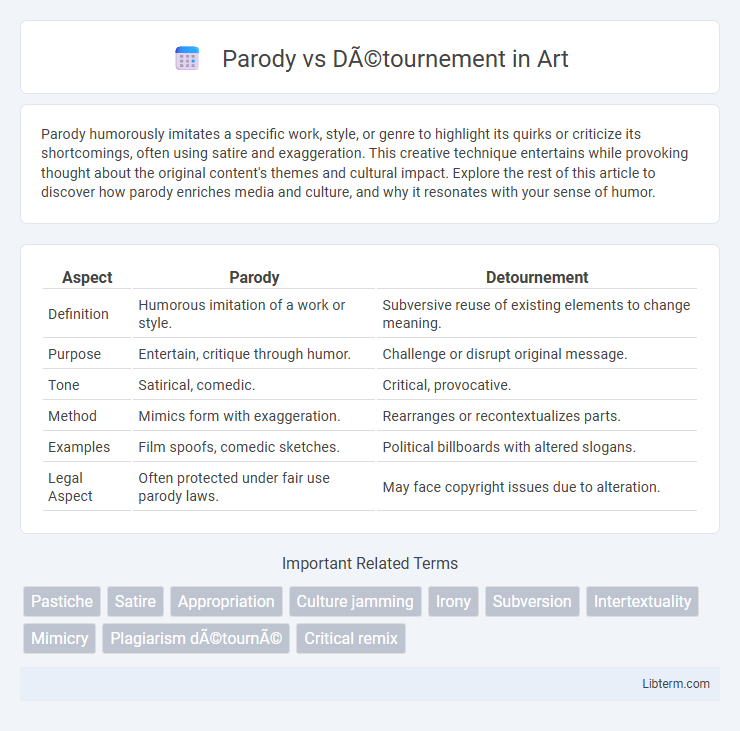Parody humorously imitates a specific work, style, or genre to highlight its quirks or criticize its shortcomings, often using satire and exaggeration. This creative technique entertains while provoking thought about the original content's themes and cultural impact. Explore the rest of this article to discover how parody enriches media and culture, and why it resonates with your sense of humor.
Table of Comparison
| Aspect | Parody | Detournement |
|---|---|---|
| Definition | Humorous imitation of a work or style. | Subversive reuse of existing elements to change meaning. |
| Purpose | Entertain, critique through humor. | Challenge or disrupt original message. |
| Tone | Satirical, comedic. | Critical, provocative. |
| Method | Mimics form with exaggeration. | Rearranges or recontextualizes parts. |
| Examples | Film spoofs, comedic sketches. | Political billboards with altered slogans. |
| Legal Aspect | Often protected under fair use parody laws. | May face copyright issues due to alteration. |
Understanding Parody and Détournement
Parody imitates the style or content of an original work to create humor or critique, often exaggerating features for satirical effect. Detournement involves subverting existing media or cultural elements by altering their meaning to challenge or undermine the original message or authority. Both techniques engage with intertextuality, but parody maintains recognizable references, while detournement transforms them into new, oppositional expressions.
Historical Origins of Parody
Parody traces its roots back to ancient Greece, where playwrights like Aristophanes crafted satirical works that imitated and humorously critiqued classical myths and epic poetry. The term derives from the Greek word "paroidia," meaning a side song or a counter-song that mimics an original piece to create comedic or critical effect. This historical foundation established parody as a literary and performing art technique aimed at social commentary through exaggerated imitation.
The Emergence of Détournement
Detournement emerged in the 1950s as a radical technique pioneered by the Situationist International, aiming to subvert and disrupt dominant cultural and political messages by recontextualizing existing media and art forms. Unlike parody, which often uses humor or satire to imitate and critique, detournement repurposes images, texts, or symbols to create new meanings that challenge societal norms and capitalist ideologies. This method gained prominence as a form of cultural resistance, directly influencing political activism and avant-garde artistic practices.
Key Differences Between Parody and Détournement
Parody involves the humorous imitation of a work, emphasizing satire and commentary through exaggeration, while detournement repurposes existing cultural elements to subvert their original meaning and create a new political or social message. Parody relies on recognition and critique of the original content, whereas detournement transforms its context to challenge dominant ideologies. The key difference lies in parody's mimicry for entertainment or critique, contrasted with detournement's strategic re-appropriation to provoke critical reflection and rebellion.
Parody in Literature, Film, and Media
Parody in literature, film, and media employs imitation of stylistic elements from original works to create humor or critique through exaggeration and incongruity. This technique serves as a form of social commentary, challenging cultural norms and artistic conventions by highlighting absurdities within popular narratives. By recontextualizing familiar motifs, parody fosters audience engagement and critical reflection on the source material's themes and values.
Détournement in Situationist Art and Activism
Detournement in Situationist art and activism subverts dominant cultural symbols by recontextualizing media and imagery to critique capitalism and consumerism. This strategy disrupts conventional meanings, transforming existing texts or artworks into tools of political resistance and social commentary. Unlike parody, which imitates for humor or satire, detournement actively reclaims and redirects messages to provoke critical awareness and revolutionary thought.
Legal and Ethical Aspects: Copyright, Fair Use, and Manipulation
Parody and detournement navigate complex legal landscapes involving copyright and fair use, where parody typically enjoys stronger protections by critiquing or commenting on original works under fair use doctrines. Detournement, which repurposes existing media to subvert or distort the original message, may face greater legal scrutiny due to potential copyright infringement and perceived manipulation beyond transformative use. Ethically, parody is often seen as a legitimate form of creative expression and social commentary, while detournement raises questions about respect for the original creator's intent and the potential for misrepresentation or cultural appropriation.
Cultural Impact: How Parody and Détournement Shape Discourse
Parody and detournement both serve as powerful cultural tools that challenge dominant narratives by recontextualizing existing works to expose contradictions and critique social norms. Parody often employs humor and satire to engage audiences, making controversial or complex subjects more accessible and prompting reflection on cultural and political matters. Detournement, rooted in Situationist practices, disrupts established meanings more radically, influencing discourse by subverting media and artistic expressions to reveal underlying power structures and inspire alternative viewpoints.
Notable Examples and Case Studies
Parody, exemplified by the film "Scary Movie" which satirizes horror genre tropes, directly imitates and humorously exaggerates original works to critique them. Detournement, as seen in the Situationist International's alteration of political advertisements in 1960s France, repurposes existing media to subvert and challenge dominant ideological messages. Notable case studies like Banksy's street art combine detournement's tactics by transforming public spaces with provocative imagery that critique social and political issues.
The Future of Parody and Détournement in Digital Culture
The future of parody and detournement in digital culture hinges on their evolving roles as tools for social critique and creative expression amid rapid technological advancements. Platforms like TikTok and YouTube amplify these forms by enabling widespread, instantaneous replication and modification of media, challenging traditional notions of originality and authorship. Emerging AI-generated content further blurs boundaries, prompting ongoing debates about copyright, ethics, and the transformative potential of digital remix cultures.
Parody Infographic

 libterm.com
libterm.com